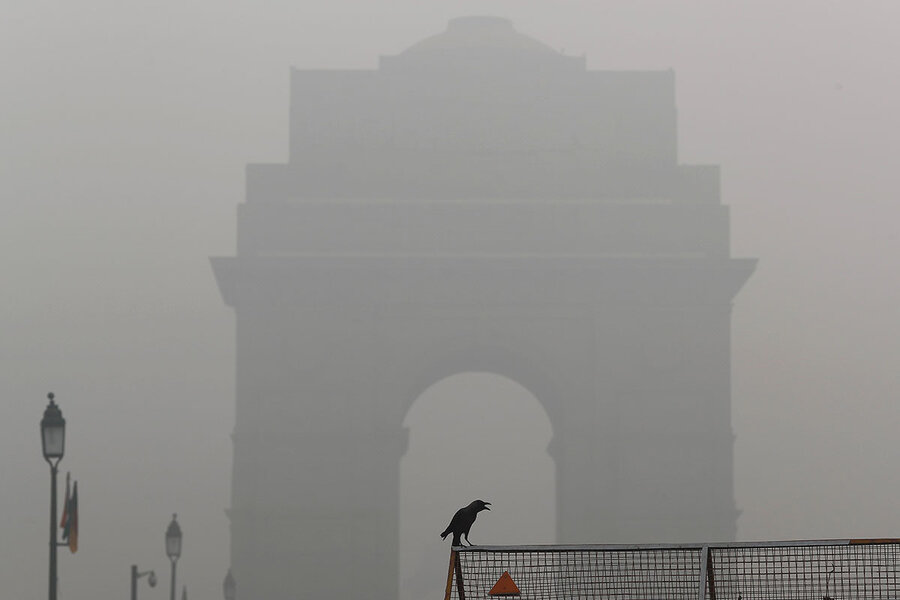Teen power: An Indian girl invents a solar iron to reduce smog
Loading...
| Bhubaneswar, India
On India’s residential streets, amid the tea vendors and vegetable sellers, ironing “wallahs” press clothes each day for millions of Indians, smoothing out wrinkles with iron boxes packed with hot charcoal.
But India’s 10 million ironing carts and shops take a hefty toll on the country’s forests. Each uses, on average, more than 11 pounds of charcoal each day, the government’s science and technology department estimates.
Now, however, a teenage girl, troubled by the heaps of used charcoal left by her local ironing vendor and by his painful wheeze from pollution, has developed an alternative: an award-winning solar-powered iron.
“I calculated the enormous quantity of charcoal being used, the pollution from it that worsens climate change, damages Mother Earth and human health. I wanted to create a renewable resource to replace charcoal,” said Vinisha Umashankar from her hometown of Tiruvannamalai, in India’s southern Tamil Nadu state.
This week her innovation was recognized with the Children’s Climate Prize for its contributions to cleaner air. The prize, backed by a Swedish energy company, includes 100,000 Swedish krona ($11,600) to further develop the project.
It is just one of several national and international prizes Vinisha has won for her innovation: a wheeled cart equipped with solar panels and batteries sufficient to power a steam iron.
Solar powered street cart
Panels on the cart’s roof produce solar power that can be used immediately as the cart wends its way between customers or stored in four batteries, Vinisha said.
When fully charged – which takes just under five hours in bright sunshine – each battery can power the iron for six hours, she said, providing power on cloudy days, though the cart can also run on grid electricity or a generator in a pinch.
To boost earnings for ironing vendors, the carts are also equipped with a mobile phone recharging station and a coin-operated telephone for making calls.
Vinisha said she hopes the cart – which she developed after school over six months – will improve incomes and health for ironing vendors and offer them “a dignified life.”
It could also be used in other developing countries, she told the Thomson Reuters Foundation in a telephone interview.
She said she had designed the cart so it was easy to operate – the system takes 15 minutes to learn – and she planned to produce online videos to help those who speak other languages understand how to use it.
“Today, solar energy is inevitable,” particular in sunny nations such as India, where some parts of the country get 300 days of sun a year, she said.
The country receives enough sunshine to produce solar power equivalent to 3,000 times the country’s current energy consumption, she added.
Marie Curie is her role model
While Vinisha developed the detailed design, the first full-scale working prototype was put together and tested last December by the National Innovation Foundation, which operates under India’s Department of Science and Technology.
The foundation has also applied for a patent for the device, on Vinisha’s behalf.
The girl, who said she sees radioactivity scientist Marie Curie as a role model, said the cart could save a “countless number of trees.”
She said she had read that a large tree can produce enough oxygen for five people in a day – and mature trees are most likely to be logged as they produce the best charcoal.
“What’s the point of planting trees if we can’t stop cutting trees for making unsustainable charcoal?” she asked.
She said she believes ironing vendors will make the switch to her device if it is cost effective.
Enough charcoal for two day of ironing costs 700 to 1,000 rupees ($9 to $13), she said. The cart, as currently configured, by comparison, costs 40,000 rupees ($540).
But Vinisha said she hopes to use her prize money to develop a new prototype that will reduce costs and boost efficiency.
“In the long run my innovation will not only work out cheaper for vendors but help the environment too,” she predicted, with each cart’s solar panels and batteries built to last at least eight years.
Sam Barratt, of the United Nations Environment Program and one of the members of the jury for the Children’s Climate Prize, said Vinisha and other young innovators were “coming at the challenge with all the smarts, passion, and energy that is needed to change the future to the one we all need.”
Vinisha said her parents and grandparents had talked about how it was cooler and seasons were more predictable when they were younger, while she and others have noticed increasing heat and pollution.
“This generation ... wants normal weather, which also will reduce droughts and floods. That is one reason why we take so much interest in climate change,” she said.
This story was reported by the Thomson Reuters Foundation.







